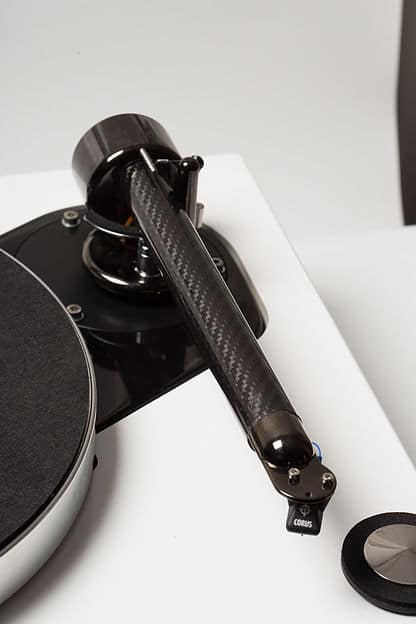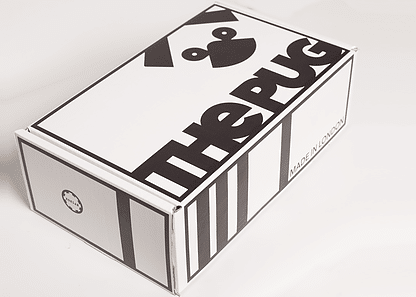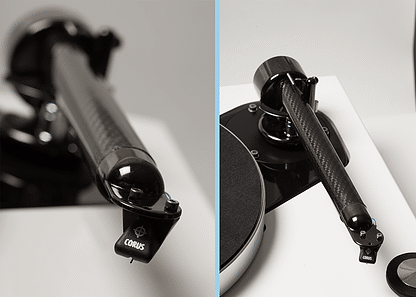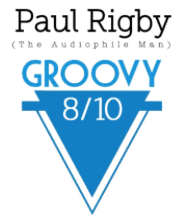The Article
Roksan’s new tonearm, The Pug: Pug Ugly
3rd March 2016
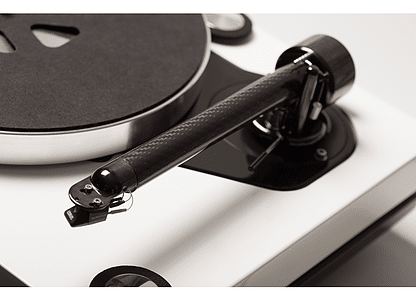
Created to fill a mid-price gap, Paul Rigby reviews Roksan’s new turntable arm, The Pug
Essentially, the new unipivot Pug arm replaces the long-standing Tabriz because, said Roksan boss, Tufan Hashemi, “The original Tabriz arm tube had around twenty-four different processes in its manufacture. Today, with the C-in-C machines that we have and the programming we can perform on it, I can get a much lighter and stiffer and better machined tonearm and headshell, in one piece simply by machining and drilling it out. This was impossible twenty years ago.”
The basis of the Pug is…The Wand? It does resemble this arm to some degree don’t you think? What I was going to say was that the carbon fibre tube forms the basis of the Pug, offering greater rigidity and a more pleasing finish than a similar aluminium tube. Sitting on a Tungsten-Carbide, three-point bearing, featuring an aluminium headshell and a polished brass yoke, the Pug allows you to tweak to your heart’s content. You can easily change VTA, azimuth and more. The counterweight utilises a range of screw-in weights plus rings for fine tuning. A moveable ‘doughnut’ weight was rejected because, “It would look ugly! I wanted a compact, tight arm. Nothing should move.”
Ah, yes. Aesthetics. On that subject, The Pug is hardly Venus incarnate is it?
“That’s why I called it The Pug!” laughed Hashemi. “The real Pug is a lovely dog, ugly but endearing. The more I look at this arm, the more I fall in love with it. It’s a chunky little thing that plays music well.”
This review sample is beta-esque as a package. It includes an early manual (to be re-designed) accessible by USB only (an A5 paper version is under consideration), an installation tool (that may now be removed and changed) and a basic lead (to be upgraded) plus a simple tracking weight gauge and, of all things, a Roksan key-ring.
Installation from the rather cute box (Porsche-designed!) was straightforward while tweaking (i.e. VTA, etc) was easily implemented.
SOUND QUALITY
I began with Bruce Brubaker’s solo piano piece via his Glass Piano LP and the Philip Glass composition, Mad Rush. Immediately, the Pug offered tremendous focus. When piano keys were hit, there was a great emphasis on the strike. This added a solidity during the initial delicate early moments of the track and prevented extraneous frequencies from blurring the upper mids. The latter was most impressive during the first crescendo that featured hard hitting keys and a trilling, multifarious series of keyboard runs that could have easily have added a blooming cloud of both treble and midrange. The Pug was having none of that. The focus produced space and air that gave the broad soundstage a grandiose feel and one of great presence. That is, Brubaker sounded as if he was in the height of concentration, giving his all for this one performance. The notational separation, how each struck piano key produces a distinct, well-defined and distinct response, was impressive.
During the repeated crescendos, there were secondary, almost random, clanks and bangs as Brubaker gave his all. These fripperies were both clear and tightly formed by the Pug, producing an almost chiming effect at times.
I then moved onto harder rock from 1971 and the Electric Light Orchestra with First Movement. This track was notable for featuring two principle stars: the Spanish-type acoustic guitar that initiated the track and also served as the ‘lead vocal’ throughout plus the bass-ridden cellos that acted as bully-boy heavies, bossing the presentation. The instrumental separation allowed each to take a star role, along with the rest of the well defined instruments over the broad and busy soundstage. The cellos were meaty, hefty yet individual string twangs were not neglected or recessed. Far from it, any tiny mistake was tracked well while the guitar was detailed, characterful and exhibited a high degree of clarity. Percussion was big, bold and forceful and pushed the track onwards with gusto while the overall mastering was not neglected by The Pug. This track was recorded back in 1971 and The Pug managed to retain and project a golden, early-70s valve-drenched glow that gave the music that distinct, period charm.
CONCLUSION
Easy to install and eminently tweakable, The Pug might not be the most aesthetically pleasing design in terms of competing turntable arms and I do have an issue with the lack of a secure arm rest – which can cause accidents if you’re not careful – but, where it counts, in terms of sheer sound quality, it’s a winner. The sense of sharp, clear and well-defined midrange tones prevents information being lost in the blur. The Pug allows music to convey a wealth of information and it does so with some power and propulsion. As such, the Pug demands you attention and, of course, a demo.
ROKSAN THE PUG ARM
Price: £1,375
Website: www.henleydesigns.co.uk
Tel: 01235 511166
Good: focus, bass impact, transparency, airy mids
Bad: no secure arm rest
Rating: 8
REFERENCE SYSTEM
Wilson Benesch Full Circle turntable
0.5 carbon fibre arm
Oyaide platter mat
Ortofon Cadenza Bronze cartridge
Icon PS3 Phono amplifier
Aesthetix Calypso Pre-amp
Icon MB845 Mk.II monoblocks
Quad ESL-57 One Thing modified speakers
Tellurium Q speaker/phono cables
Vertex AQ mains cables and power blocks

